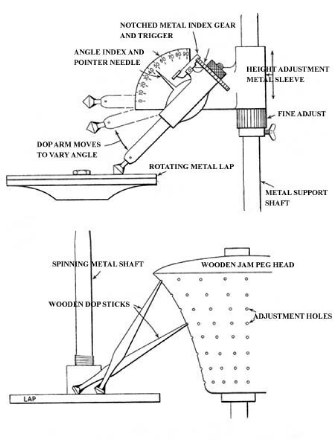Home | About Me | Jewelry Designs | Gemstones | Mineral Specimens | Mine Info | Orders | FAQs | Contact | Links |
||
 |
||||
 |
||||
Precision Cut vs. Native Cut Gemstones
Inexpensive gem material such as low quality quartz, garnet, topaz, etc. is often faceted in foreign countries where the cost of labor is extremely low. Stones of low quality that are cut in countries such as Brazil, India, and elsewhere are often referred to as "Native Cut" gemstones. Gemstones obtained from the faceting of low-quality gem materials are, by nature, of low value. No matter how perfect the faceting, the value of the faceted gemstone will not be much greater than the cost of the rough gem material itself.
Fine gem material (pieces of good size, color and clarity) can be crafted into valuable faceted gemstones. Such high quality rough warrants the extra time and effort required to finish a gem of good proportion, finish, and brilliance. In countries where the cost of labor is very low, the cost of a "Native Cut" one carat colorless topaz may be as little as 50 cents or less. If cut in the U.S., Germany, or elsewhere, by a skilled craftsman, the labor cost-component of a "Precision Cut" one carat imperial topaz may be as much as 30 to 50 dollars.
The price and quality of the equipment used in "Precision" vs "Native" faceting is also quite different. Faceting is a process of grinding flats on a piece of gem material by pressing the gem rough against a rotating disk (called a lap) that is impregnated with an abrasive (usually powdered diamond). The figure shown here illustrates the difference between the equipment commonly used for "Native Cut" and "Precision Cut" gemstones. The jamb peg faceting head used for "Native Cut" stones is inexpensive and simple in design and construction. The head and dopsticks are made of wood. In contrast, the mechanical head and dopsticks of a precision faceting machine are made of metal, and are precisely machined and manufactured.
Jamb Peg ("Native Cut") gemstones may or may not be very beautiful, but a careful examination of the cutting will show that facet shapes are often quite irregular. Facet junctions are imprecise, and facets are not flat or well polished. "Native Cut" gemstones are often cut with the intent of retaining as much rough gem weight as possible. This is done to the detriment of the optical performance of the final gemstone. If a gemstone is cut on a precision faceting machine, and if the gem cutter carries out his job properly, the facets on the gem will be symmetrical and will meet precisely. The facets will be optically flat, and they will be of fine polish. Proper faceting angles will be used to obtain good symmetry and brilliance.